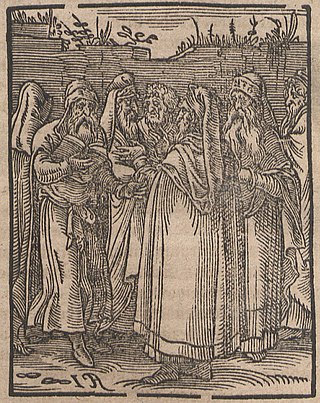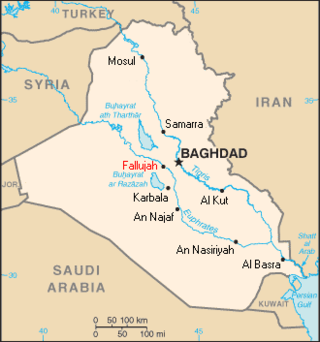
Kabbalah or Qabalah is an esoteric method, discipline and school of thought in Jewish mysticism. A traditional Kabbalist is called a Mekubbal. The definition of Kabbalah varies according to the tradition and aims of those following it, from its origin in medieval Judaism to its later adaptations in Western esotericism. Jewish Kabbalah is a set of esoteric teachings meant to explain the relationship between the unchanging, eternal God—the mysterious Ein Sof —and the mortal, finite universe. It forms the foundation of mystical religious interpretations within Judaism.

Isaac ben Solomon Luria Ashkenazi, commonly known in Jewish religious circles as Ha'ari, Ha'ari Hakadosh or Arizal, was a leading rabbi and Jewish mystic in the community of Safed in the Galilee region of Ottoman Syria, now Israel. He is considered the father of contemporary Kabbalah, his teachings being referred to as Lurianic Kabbalah.

The machzor is the prayer book which is used by Jews on the High Holy Days of Rosh Hashanah and Yom Kippur. Many Jews also make use of specialized machzorim on the three pilgrimage festivals of Passover, Shavuot, and Sukkot. The machzor is a specialized form of the siddur, which is generally intended for use in weekday and Shabbat services.

Hai ben Sherira better known as Hai Gaon, was a medieval Jewish theologian, rabbi and scholar who served as Gaon of the Talmudic academy of Pumbedita during the early 11th century. He was born in 939 and died on March 28, 1038. He received his Talmudic education from his father, Sherira ben Hanina, and in early life acted as his assistant in teaching. In his forty-fourth year he became associated with his father as "av bet din," and with him delivered many joint decisions. According to Sefer HaKabbalah of Rabbi Abraham ben David (Ravad), he was the last of the Geonim.

Hoshana Rabbah is the seventh day of the Jewish holiday of Sukkot, the 21st day of the month of Tishrei. This day is marked by a special synagogue service, the Hoshana Rabbah, in which seven circuits are made by the worshippers with their lulav and etrog, while the congregation recites Hoshanot. It is customary for the scrolls of the Torah to be removed from the ark during this procession. In a few communities a shofar is sounded after each circuit.
Judah ben Samuel of Regensburg, also called Yehuda HeHasid or 'Judah the Pious' in Hebrew, was a leader of the Chassidei Ashkenaz, a movement of Jewish mysticism in Germany considered different from the 18th-century Hasidic movement founded by the Baal Shem Tov.
MalkielAshkenazi was a Sephardic rabbi and leader of the Jewish community in Hebron in 1540.

The Abraham Avinu Synagogue is a synagogue in the Jewish Quarter of Hebron. Built by Sephardic Jews led by Hakham Malkiel Ashkenazi in 1540, its domed structure represented the physical center of the Jewish Quarter of the Old City of Hebron. The synagogue became the spiritual hub of the Jewish community there and a major center for the study of Kabbalah. It was restored in 1738 and enlarged in 1864; the synagogue stood empty since the 1929 Hebron massacre, was destroyed after 1948, was rebuilt in 1977 and has been open ever since.
Rabbi Yaakov Culi was a Talmudist and biblical commentator of the seventeenth and eighteenth centuries who died in Constantinople on August 9, 1732.

Jonah ben Abraham Gerondi, also known as Jonah of Girona and Rabbeinu Yonah, was a Catalan rabbi and moralist, cousin of Nahmanides. He is most famous for his ethical work The Gates of Repentance.
Shem Tov ben Abraham ibn Gaon was a Spanish Talmudist and kabbalist.
Moses ben Mordecai Zacuto, also known by the Hebrew acronym RaMa"Z, was a rabbi, Kabbalist, and poet. Zacuto, who was born into a Portuguese Marrano family in Amsterdam, studied Jewish subjects under Saul Levi Morteira. He also studied secular subjects, such as the Latin language. As a pupil of Morteira, he may also have been, as a youth still in Amsterdam, a fellow student of Baruch Spinoza.
Naphtali Hirsch ben Eliezer Treves was a kabalist and Rabbinic scholar of the 16th century who officiated as Hazzan and rabbinic judge in Frankfort-on-the-Main. He was the author of Mala Ha'aretz Deah (1560), a famous cabalistic commentary on the Siddur (prayer-book), printed at Thüngen by his son Rav Eliezer Treves, Chief Rabbi of Frankfurt, and also of Naftule Elokim, an index to Bahya ben Asher's commentary on the Pentateuch. The preface to the Naftule Elokim consists partly of the result of private studies and partly of quotations from other cabalistic works. Treves also wrote, a supercommentary on Rashi, which is still extant. Naphtali Hirz engaged in disputations with Christian scholars, and he made comments on the pronunciation of German language. He is especially important for his accounts of Jewish customs and ceremonies.
Lurianic Kabbalah is a school of Kabbalah named after Isaac Luria (1534–1572), the Jewish rabbi who developed it. Lurianic Kabbalah gave a seminal new account of Kabbalistic thought that its followers synthesised with, and read into, the earlier Kabbalah of the Zohar that had disseminated in Medieval circles.
Yohanan Alemanno was an Italian Jewish rabbi, noted Kabbalist, humanist philosopher, and exegete, and teacher of the Hebrew language to Italian humanists including Pico della Mirandola. He taught that the Kabbalah was divine magic.
Ezra Malki was rabbi of Rhodes in the seventeenth century; he was brother-in-law of Hezekiah de Silva, the author of "Peri Ḥadash."
David ben Judah Messer Leon was an Italian rabbi, physician and writer, who defended the value of secular disciplines and the Renaissance humanities as an important part of traditional Jewish studies.
Shalom Ben Moses Buzaglo was a Moroccan kabbalist born in Marrakesh and filled the position of dayyan. Owing to voyages in the Orient made in his capacity of collector of alms for the relief of the poor in Palestine, he became acquainted with the chief Kabbalists of the period. He also visited Europe, and sojourned for some time in London. He was tortured by the Sultan and left for England in 1745, where he remained until his death.
Avinu means "Our Father" in Hebrew. The term may also refer to:
Tikunei haZohar, also known as the Tikunim (תקונים), is a main text of the Kabbalah which was composed in the 14th century.







